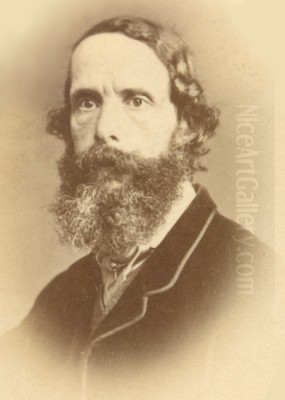
Sidney Richard Percy stands as one of the most accomplished and popular landscape painters of the Victorian era in Britain. Flourishing during a time when landscape painting reached new heights of public appreciation, Percy captured the romantic beauty of the British countryside, particularly the dramatic terrains of North Wales and the Scottish Highlands. His work is characterized by meticulous detail, atmospheric depth, and a profound sensitivity to the effects of light. As a key member of the renowned Williams family of painters, Percy carved out a distinct identity, becoming a commercially successful and critically respected artist whose works continue to be admired today.
Early Life and Artistic Beginnings
Sidney Richard Percy Williams was born in London on March 22, 1821. He was the fifth son of the painter Edward Williams (1781–1855) and Ann Hildebrandt. His father was a highly regarded landscape artist himself, descended from the engraver William Williams and related through marriage to artists James Ward R.A. and George Morland. This placed young Sidney within an extensive network of artistic talent and tradition from birth. He grew up in Barnes, London, in a household where painting was the family trade.
He received his artistic training primarily from his father, alongside his brothers. The Williams household was effectively an art school, with the sons learning the techniques of landscape painting, including observation from nature, sketching, and oil painting techniques. This immersive environment fostered a high degree of technical skill among the siblings, all of whom became professional painters.
To distinguish himself professionally from his father and numerous artist brothers, Sidney adopted the name "Sidney Richard Percy." From around 1841 onwards, he signed his works primarily as "S. R. Percy." This decision was crucial in establishing his individual artistic identity in a crowded field, particularly one populated by his own family members. His chosen name became the one under which he achieved widespread recognition.
The Williams Family Dynasty
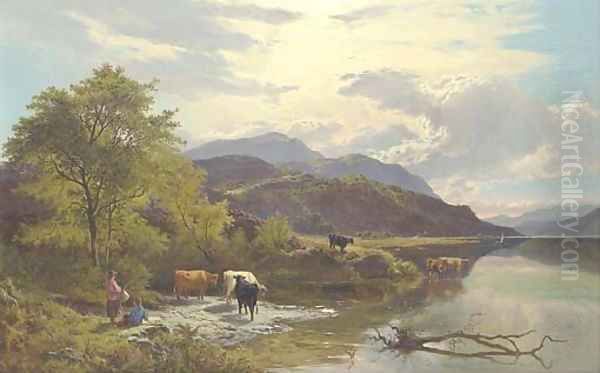
The Williams family represents a unique phenomenon in British art history. Edward Williams fathered six sons who all became notable landscape painters: Edward Charles Williams (1807–1881), Henry John Boddington (1811–1865, who adopted his wife's surname), George Augustus Williams (1814–1901), Arthur Gilbert (1819–1895, who also changed his surname for distinction), Sidney Richard Percy himself (1821–1886), and Alfred Walter Williams (1824–1905).
This collective output meant that the name "Williams" was ubiquitous in mid-19th-century landscape painting exhibitions. While sharing a foundational style learned from their father, each brother developed individual characteristics. Percy arguably became the most commercially successful and critically acclaimed of the siblings during his lifetime. His decision to adopt the name "Percy" proved astute, allowing collectors and critics to identify his work clearly amidst the prolific output of his relatives. The family's collective contribution, however, remains a testament to the artistic environment fostered by Edward Williams.
Developing a Distinctive Style: Influences and Techniques
Percy's art is firmly rooted in the British landscape tradition, showing the influence of earlier masters while developing a personal vision. The legacy of Romanticism, particularly the work of J.M.W. Turner concerning light and atmosphere, and John Constable regarding fidelity to nature, can be discerned in his approach. However, Percy forged his own path, blending topographical accuracy with a romantic sensibility.
His style is often described as Romantic Realism. He excelled at capturing the specific character of the locations he painted, rendering geological formations, foliage, and architectural details with considerable precision. This realism was combined with a masterful handling of light and atmosphere, creating moods that ranged from the tranquil and pastoral to the dramatic and sublime. He was particularly adept at depicting misty mornings, the golden glow of late afternoons, and the interplay of sunlight and shadow across mountains and water.
Percy frequently travelled in search of subjects, making sketching tours to North Wales, the Lake District, Scotland, the Isle of Skye, and parts of Southern England, including Devon and the Thames Valley. His most iconic works often feature the rugged mountains and serene lakes of Snowdonia or the dramatic glens and lochs of the Scottish Highlands. He often included small figures or, more characteristically, groups of Highland cattle or sheep, which added life and scale to his landscapes, enhancing their pastoral or wild character. His depiction of foliage was noted for its botanical accuracy.
A Prolific Career: Exhibitions and Recognition
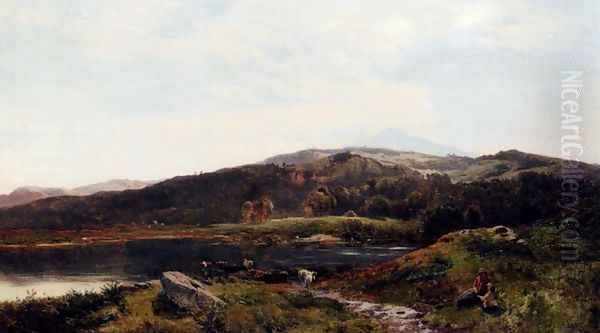
Percy began exhibiting his work at a young age. His debut at the prestigious Royal Academy of Arts in London occurred in 1842 with a painting titled Landscape with Figures. This marked the beginning of a long and successful exhibiting career. He continued to show works regularly at the Royal Academy for over four decades, submitting nearly every year until his death.
Beyond the Royal Academy, Percy was a frequent exhibitor at other major London venues, including the British Institution (where he exhibited over 70 works) and the Society of British Artists on Suffolk Street (later the Royal Society of British Artists). His paintings were well-received by both critics and the public, finding favour with the burgeoning middle-class collectors of the Victorian era who appreciated his accessible yet skillfully executed views of familiar British scenery.
His reputation extended beyond Britain. His works were included in international exhibitions, such as those held in Paris, New York, and Melbourne, attesting to his standing in the wider art world. This popularity translated into commercial success, particularly during the mid-Victorian period, making him one of the most sought-after landscape painters of his generation. His consistent output and recognisable style ensured a steady demand for his work.
Iconic Landscapes: Favourite Haunts and Representative Works
While Percy painted various parts of Britain, he is most strongly associated with the landscapes of North Wales and the Scottish Highlands. These regions provided the dramatic mountain scenery, expansive lakes, and atmospheric conditions that perfectly suited his artistic temperament. He returned to these areas repeatedly throughout his career.
In North Wales, Snowdonia was a particular favourite. Locations such as Llyn Gwynant, Llyn-y-Ddinas, the Vale of Llanberis, Moel Siabod, and the areas around Betws-y-Coed and Capel Curig feature prominently in his oeuvre. Paintings like Llyn-y-Ddinas, North Wales are considered among his masterpieces, showcasing his ability to capture the grandeur of the mountains reflected in calm lake waters, often under soft, diffused light. A View on the Machno, North Wales and Near Bettws-y-Coed are other examples demonstrating his skill in rendering rocky streams and wooded valleys.
His Scottish scenes often depict the rugged beauty of the Highlands, featuring dramatic peaks, deep glens, and herds of Highland cattle. Glen Falloch and views in the Trossachs are representative of his work in Scotland. He also painted extensively in the Lake District, capturing the picturesque beauty of areas like Langdale and Grasmere. The Langdale Pikes from Lowther exemplifies his treatment of this region.
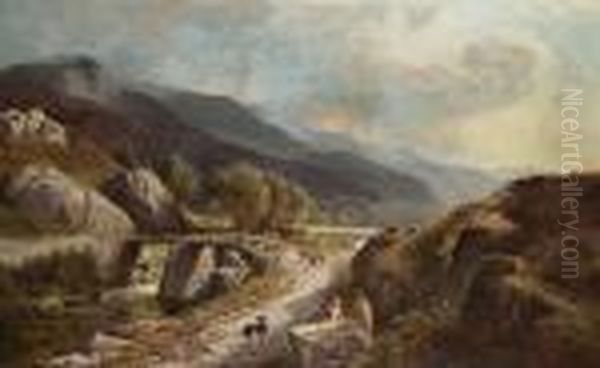
A notable work mentioned in the initial information is A Rest on a Roadside Bank (1861), likely depicting a more pastoral scene closer to his home surroundings, showcasing his versatility in capturing different aspects of the British landscape. Throughout these works, his consistent attention to detail, harmonious composition, and evocative use of light are hallmarks of his style.
Innovation and Controversy: The Use of Photography
In an interesting intersection of art and technology, Sidney Richard Percy was also an enthusiastic amateur photographer. From the 1860s onwards, he embraced the relatively new medium, not just as a hobby but as a tool to aid his painting process. He is known to have taken photographs during his sketching tours, using them back in his studio as reference material for compositions and details.
This practice was somewhat controversial at the time. Some critics and fellow artists felt that using photographs undermined the traditional skills of drawing and observation from nature, viewing it as a form of "cheating." Photography's role in art was hotly debated throughout the latter half of the 19th century. Percy, however, seems to have been relatively open about his use of photographic aids, unlike some contemporaries who might have used them more discreetly.
His photographic activities demonstrate a forward-thinking engagement with new technologies. Rather than seeing photography as a threat, Percy appears to have recognised its potential to enhance the accuracy and detail of his landscape paintings, particularly in capturing complex geological formations or fleeting atmospheric effects. This pragmatic approach aligns with the Victorian era's broader fascination with scientific and technological advancements. Other artists, like Edgar Degas, also explored photography's potential, though Percy was among the earlier landscape painters known to integrate it into his working method.
Personal Life: Family, Friendships, and Hardships
In 1857, Sidney Richard Percy married Emily Charlotte Fairlam (1835-1904). The couple settled initially in Florence Villa in Wimbledon, Surrey. They later moved to Hill House in the village of Redhill, Surrey, around 1863, seeking quieter surroundings conducive to landscape painting. Their home reportedly had fine views over the Surrey countryside. They had one daughter, Amy Dora Percy (born 1860), who later married a Richard Williams in 1886.
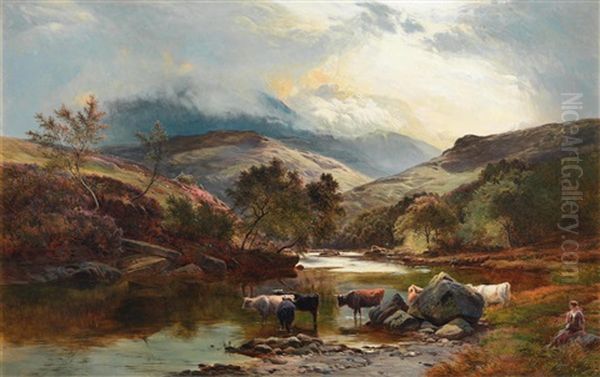
While Percy achieved considerable professional success, his personal life included periods of difficulty. The provided information mentions potential financial pressures related to his marriage, although details remain somewhat unclear. A more documented tragedy was the death of his eldest son, Gordon, in a riding accident in 1850 (though other sources suggest his only documented child was Amy; this point requires clarification, perhaps the Chinese source conflated information or referred to another family member). Such personal losses undoubtedly impacted the artist.
Despite these challenges, Percy maintained a productive career and appears to have had amicable relationships within the art world. The initial information mentions a friendship with the watercolourist William Callow (1812–1908), another prominent landscape artist. His family connections also linked him socially to figures like James Ward and George Morland through his mother's lineage, placing him within a well-established artistic milieu. He would have known many of his contemporaries exhibiting alongside him, such as Benjamin Williams Leader (1831–1923) and Alfred de Bréanski Sr. (1852–1928), who also specialized in popular landscape views, particularly of Wales and Scotland.
Later Years and Legacy
Sidney Richard Percy continued to paint and exhibit actively throughout the 1870s and into the 1880s. He maintained his focus on the landscapes that had brought him fame, consistently producing detailed and atmospheric views that appealed to Victorian tastes. His later works show a continuity of style and technique, demonstrating his enduring commitment to his artistic vision.
His life took a difficult turn in his final year. In 1886, while living in Sutton, Surrey, he suffered a severe accident, reportedly involving a fall during a horse ride or from a carriage. The injuries necessitated the amputation of his right leg. Sadly, he did not recover fully from this ordeal and passed away shortly thereafter, on April 13, 1886, at his home, "Woodseat," in Sutton. He was 65 years old.
Percy left behind a significant body of work and a strong reputation. His paintings were already represented in public collections during his lifetime and continue to be held by major institutions today, including the Tate Britain in London, the Victoria and Albert Museum, and numerous regional galleries across the UK, such as the Wolverhampton Art Gallery, which holds a notable collection. His work also remains popular in the art market, frequently appearing at auction and commanding respectable prices.
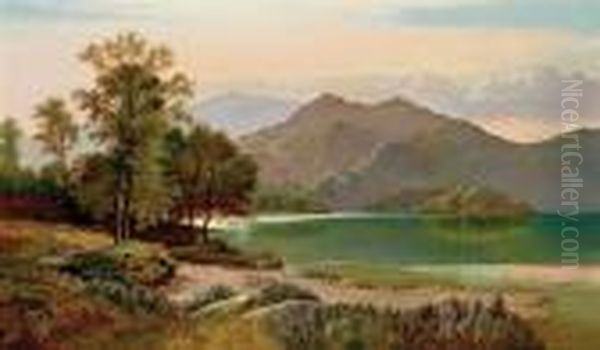
His legacy lies in his contribution to the Victorian landscape tradition. He successfully blended topographical accuracy with romantic feeling, creating enduring images of the British countryside. Alongside contemporaries like Myles Birket Foster (in watercolour) or Atkinson Grimshaw (known for urban nocturnes but also atmospheric landscapes), Percy captured a particular vision of Britain that resonated deeply with his audience. While perhaps not as revolutionary as Turner or Constable, or as scientifically precise as Pre-Raphaelite landscapists like John Brett, Percy excelled in creating beautifully crafted, evocative landscapes that defined popular taste for much of the 19th century.
Conclusion: An Enduring Vision of Britain
Sidney Richard Percy remains a significant figure in 19th-century British art. As a leading member of the remarkable Williams family of painters, he established a distinct and highly successful career. His detailed yet atmospheric depictions of the mountains, lakes, and valleys of North Wales, Scotland, and the Lake District captured the public imagination and earned him critical acclaim. His technical skill, combined with a romantic sensitivity to light and mood, resulted in landscapes that are both topographically recognisable and emotionally resonant.
His willingness to embrace photography as an artistic tool marks him as an artist engaged with the technological changes of his time. Despite personal hardships, he maintained a prolific output and a consistent artistic vision throughout his life. Today, his paintings offer a captivating window onto the Victorian appreciation of the natural world and stand as enduring testaments to the beauty of the British landscape, skillfully rendered by a master of his craft. His work continues to be cherished by collectors and museum visitors alike, securing his place as a key landscape painter of his era.